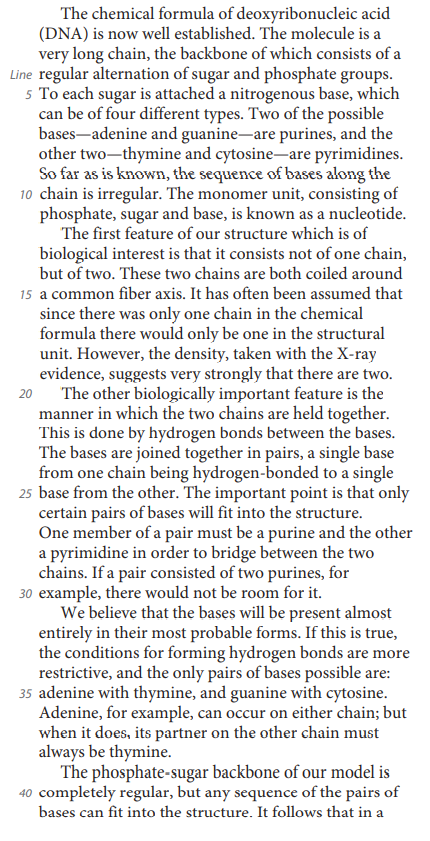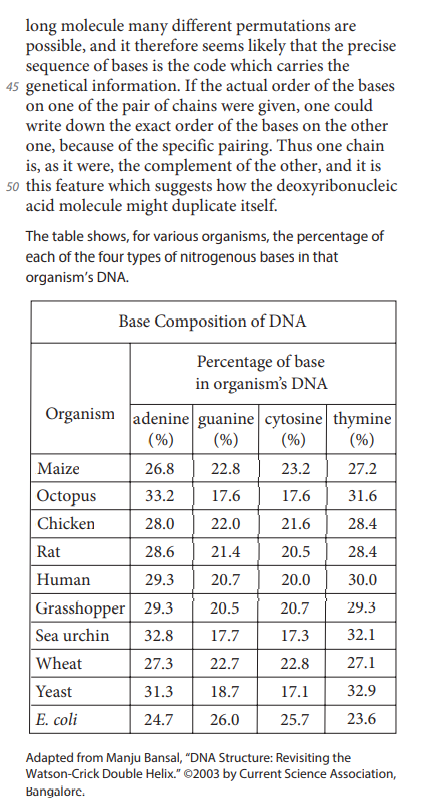SAT (Scholastic Assessment Test) is a standard test, used for taking admission to undergraduate programs of universities or colleges of the United States. SAT is developed and published by the College Board, an organization in the United States, administered by the Educational Testing Service. In this article of AKVTutorials, you will get SAT Practice Test 3 Answers | SAT 2024 Prep Online Tutor AMBiPi.
SAT Reading Practice Passage
This passage is adapted from J.D. Watson and F. H. C. Crick, “Genetical Implications of the Structure of Deoxyribonucleic Acid.” ©1953 by Nature Publishing Group. Watson and Crick deduced the structure of DNA using evidence from Rosalind Franklin and R. G. Gosling’s X-ray crystallography diagrams of DNA and Erwin Chargaff’s data on the base composition of DNA.


SAT Reading Comprehension Practice Test Questions
SAT Practice Test 3 Question No 1
The authors use the word “backbone” in lines 3 and 39 to indicate that
Option A: only very long chains of DNA can be taken from an organism with a spinal column.
Option B: the main structure of a chain in a DNA molecule is composed of repeating units.
Option C: a chain in a DNA molecule consists entirely of phosphate groups or sugars
Option D: nitrogenous bases form the main structural unit of DNA.
SAT Practice Test 3 Answer No 1
Show/Hide Answer
Option B :
Lines 2-4 of the passage describe DNA as “a very long chain, the backbone of which consists of a regular alternation of sugar and phosphate groups.”The backbone of DNA, in other words, is the main structure of a chain made up of repeating units of sugar and phosphate.
Choice A is incorrect because the passage describes DNA on the molecular level only and never mentions the spinal column of organisms. Choice C is incorrect because the passage describes the backbone of the molecule as having “a regular alternation” of sugar and phosphate, not one or the other. Choice D is incorrect because the nitrogenous bases are not the main structural unit of DNA; rather, they are attached only to the repeating units of sugar.
SAT Practice Test 3 Question No 2
A student claims that nitrogenous bases pair randomly with one another. Which of the following statements in the passage contradicts the student’s claim?
Option A: Lines 5-6 (“To each… types”)
Option B: Lines 9-10 (“So far… irregular”)
Option C: Lines 23-25 (“The bases… other”)
Option D: Lines 27-29 (“One member… chains”)
SAT Practice Test 3 Answer No 2
Show/Hide Answer
Option D :
The authors explain that hydrogen bonds join together pairs of nitrogenous bases and that these bases have a specific structure that leads to the pairing: “One member of a pair must be a purine and the other a pyrimidine to bridge between the two chains” (lines 27-29). Given the specific chemical properties of a nitrogenous base, it would be inaccurate to call the process random.
Choice A is incorrect because lines 5-6 describe how nitrogenous bases attach to sugar but not how those bases pair with one another. Choice B is incorrect because lines 9-10 do not contradict the student’s claim. Choice C is incorrect because lines 23-25 describe how the two molecules’ chains are linked, not what the specific pairing between nitrogenous bases is.
SAT Practice Test 3 Question No 3
In the second paragraph (lines 12-19), what do the authors claim to be a feature of biological interest?
Option A: The chemical formula of DNA
Option B: The common fiber axis
Option C: The X-ray evidence
Option D: DNA consisting of two chains
SAT Practice Test 3 Answer No 3
Show/Hide Answer
Option D :
In lines 12-14 the authors state: “the first feature of our structure which is of biological interest is that it consists not of one chain, but two.”
Choices A and B are incorrect because lines 12-14 explicitly state that it is the two chains of DNA that are of “biological interest,” not the chemical formula of DNA, nor the common fiber axis those two chains are wrapped around. Choice C is incorrect because, while the X-ray evidence did help Watson and Crick to discover that DNA consists of two chains, it was not claimed to be the feature of biological interest.
SAT Practice Test 3 Question No 4
The authors’ main purpose of including the information about X-ray evidence and density is to
Option A: establish that DNA is the molecule that carries the genetic information.
Option B: present an alternate hypothesis about the composition of a nucleotide.
Option C: provide support for the authors’ claim about the number of chains in a molecule of DNA.
Option D: confirm the relationship between the density of DNA and the known chemical formula of DNA.
SAT Practice Test 3 Answer No 4
Show/Hide Answer
Option C :
In lines 12-14 the authors claim that DNA molecules appear to be comprised of two chains, even though “it has often been assumed . . . there would be only one” (lines 15-17). The authors support this claim with evidence compiled from an X-ray: “the density, taken with the X-ray evidence, suggests very strongly that there are two [chains]” (lines 18-19).
Choices A, B, and D are incorrect because the authors mention density and X-ray evidence to support a claim, not to establish that DNA carries genetic information, present a hypothesis about the composition of a nucleotide, or confirm a relationship between the density and chemical formula of DNA.
SAT Practice Test 3 Question No 5
Based on the passage, the authors’ statement “If a pair consisted of two purines, for example, there would not be room for it” (lines 29-30) implies that a pair.
Option A: purines would be larger than the space between a sugar and a phosphate group.
Option B: purines would be larger than a pair consisting of a purine and a pyrimidine.
Option C: of pyrimidines would be larger than a pair of purines.
Option D: consisting of a purine and a pyrimidine would be larger than a pair of pyrimidines.
SAT Practice Test 3 Answer No 5
Show/Hide Answer
Option B :
The authors explain that “only certain pairs of bases will fit into the structure” (lines 25-26) of the DNA molecule. These pairs must contain “a purine and the other a pyrimidine to bridge between the two chains” (lines 27-29), which implies that any other pairing would not “fit into the structure” of the DNA molecule. Therefore, a pair of purines would be larger than the required purine/pyrimidine pair and would not fit into the structure of the DNA molecule.
Choice A is incorrect because this section is not discussing the distance between a sugar and phosphate group. Choice C is incorrect because the passage never makes clear the size of the pyrimidines or purines about each other, only about the space needed to bond the chains of the DNA molecule. Choice D is incorrect because the lines do not make an implication about the size of a pair of pyrimidines about the size of a pair consisting of a purine and a pyrimidine.
SAT Practice Test 3 Question No 6
The authors’ use of the words “exact,” “specific,” and “complement” in lines 47-49 in the final paragraph functions mainly to
Option A: confirm that the nucleotide sequences are known for most molecules of DNA.
Option B: counter the claim that the sequences of bases along a chain can occur in any order.
Option C: support the claim that the phosphate-sugar backbone of the authors’ model is completely regular.
Option D: emphasize how one chain of DNA may serve as a template to be copied during DNA replication.
SAT Practice Test 3 Answer No 6
Show/Hide Answer
Option D :
The authors explain how the DNA molecule contains a “precise sequence of bases” (lines 43-44), and that the authors can use the order of bases on one chain to determine the order of bases on the other chain: “If the actual order of the bases on one of the pair of chains were given, one could write down the exact order of the bases on the other one, because of the specific pairing. Thus one chain is, as it were, the complement of the other, and it is this feature which suggests how the deoxyribonucleic acid molecule might duplicate itself ” (lines 45-51). The authors use the words “exact,” “specific,” and “complement” in these lines to suggest that the base pairings along a DNA chain is understood and predictable, and may explain how DNA “duplicate[s] itself ” (line 51).
Choice A is incorrect because the passage does not suggest that most nucleotide sequences are known. Choice B is incorrect because these lines are not discussing the random nature of the base sequence along one chain of DNA. Choice C is incorrect because the authors are describing the bases attached only to the sugar, not to the sugar-phosphate backbone.
SAT Practice Test 3 Question No 7
Based on the table and passage, which choice gives the correct percentages of the purines in yeast DNA
Option A: 17.1% and 18.7%.
Option B: 17.1% and 32.9%.
Option C: 18.7% and 31.3%.
Option D: 31.3% and 32.9%.
SAT Practice Test 3 Answer No 7
Show/Hide Answer
Option C :
Lines 6-7 state that “Two of the possible bases—adenine and guanine—are purines,” and on the table, the percentages of adenine and guanine in yeast DNA are listed as 31.3% and 18.7% respectively.
Choices A, B, and D are incorrect because they do not state the percentages of both purines, adenine, and guanine, in yeast DNA.
SAT Practice Test 3 Question No 8
Do the data in the table support the authors’ proposed pairing of bases in DNA?
Option A: Yes, because for each given organism, the percentage of adenine is closest to the percentage
of thymine, and the percentage of guanine is closest to the percentage of cytosine.
Option B: Yes, because for each given organism, the percentage of adenine is closest to the percentage of guanine, and the percentage of cytosine is closest to the percentage of thymine.
Option C: No, because for each given organism, the percentage of adenine is closest to the percentage
of thymine, and the percentage of guanine is closest to the percentage of cytosine.
Option D: No, because for each given organism, the percentage of adenine is closest to the percentage of guanine, and the percentage of cytosine is closest to the percentage of thymine.
SAT Practice Test 3 Answer No 8
Show/Hide Answer
Option A :
The authors state: “We believe that the bases will be present almost entirely in their most probable forms. If this is true, the conditions for forming hydrogen bonds are more restrictive, and the only pairs of bases possible are adenine with thymine and guanine with cytosine” (lines 31-35). The table shows that the pairs adenine/thymine and guanine/cytosine have notably similar percentages in DNA for all organisms listed.
Choice B is incorrect. Although the choice of “Yes” is correct, the explanation for that choice misrepresents the data in the table. Choices C and D are incorrect because the table does support the authors’ proposed pairing of nitrogenous bases in DNA molecules.
SAT Practice Test 3 Question No 9
According to the table, which of the following pairs of base percentages in sea urchin DNA provides evidence in support of the answer to the previous question?
Option A: 17.3% and 17.7%
Option B: 17.3% and 32.1%
Option C: 17.3% and 32.8%
Option D: 17.7% and 32.8%
SAT Practice Test 3 Answer No 9
Show/Hide Answer
Option A :
It gives the percentage of cytosine (17.3%) in sea urchin DNA and the percentage of guanine (17.7%) in sea urchin DNA. They’re near similar pairing supports the authors’ proposal that possible pairings of nitrogenous bases are “adenine with thymine, and guanine with cytosine” (line 35).
Choices B, C, and D do not provide the best evidence for the answer to the previous question. Choice B (cytosine and thymine), Choice C (cytosine and adenine), and Choice D (guanine and adenine) are incorrect because they show pairings of nitrogenous bases that do not compose a similar percentage of the bases in sea urchin DNA.
SAT Practice Test 3 Question No 10
Based on the table, is the percentage of adenine in each organism’s DNA the same or does it vary, and which statement made by the authors is most consistent with that data?
Option A: The same; “Two of… pyrimidines” (lines 6-8)
Option B: The same; “The important… structure” (lines 25-26)
Option C: It varies; “Adenine… thymine” (lines 36-38)
Option D: It varies; “It follows… information” (lines 41-45)
SAT Practice Test 3 Answer No 10
Show/Hide Answer
Option D :
The table clearly shows that the percentage of adenine in each organism’s DNA is different, ranging from 24.7% in E.coli to 33.2% in the octopus. That such variability would exist is predicted in lines 41-43, which states that “in a long molecule many different permutations are possible.”
Choices A and B are incorrect because the table shows that the percentage of adenine varies between 24.7% and 33.2% in different organisms. Choice C is incorrect because lines 36-38 state that adenine pairs with thymine but does not mention the variability of the base composition of DNA.



